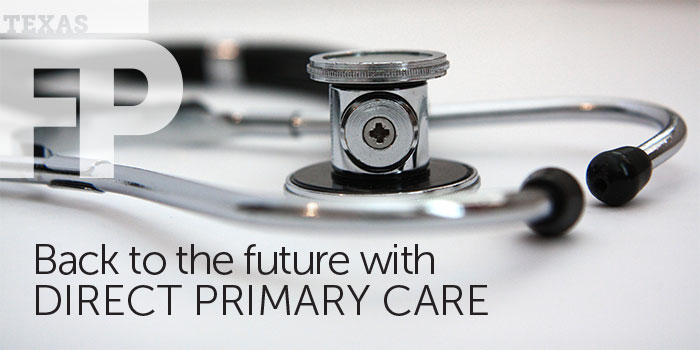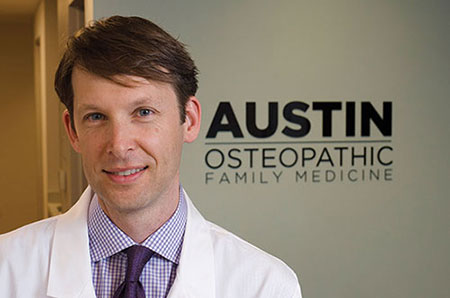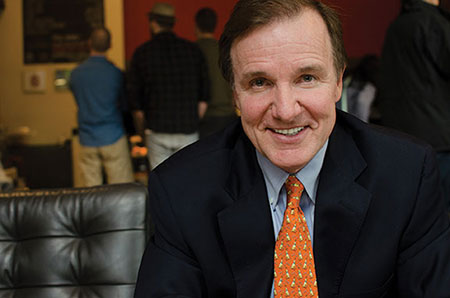Direct primary care: An alternative to fee-for-service

Direct primary care: An alternative to fee-for-service
By Kate Alfano
Unlimited time with patients, decreased practice overhead, less exposure to risk, fewer medical errors, zero insurance filing; while this sounds like a wish list for family medicine in an increasingly complex and frustrating health care system, some family physicians are embracing an expanding practice model and achieving all this and more.
Direct primary care is an alternative to insurance-based fee-for-service primary care. Physicians charge a monthly or annual fee, and in return patients receive all or most primary care services including clinical, laboratory and consultative services, and care coordination and comprehensive care management. Patients enjoy visits unhampered by a prescribed time limit and they can usually reach their physician outside of normal business hours by cell phone, text message, secure e-mail, or video chat.
Other terms are often used synonymously with DPC, including concierge medicine, but the subtle difference is in the payment. In concierge medicine, a doctor accepts insurance for routine services but also charges a membership fee that averages $150 per month, according to a January 2013 Market Watch article. While independent DPC physicians set their own fees, the average cost to the patient is about half that, roughly $80 per month.
At a time when insurance premiums are rising and more patients are switching to high-deductible health insurance plans for catastrophic coverage, patients, physicians, employers, advocacy organizations, even Medicaid programs are taking a second look at a more affordable way to keep physicians’ doors open and patients well.
Jay Keese is the executive director of the Direct Primary Care Coalition, an advocacy group representing DPC physicians, residents, and medical students. The organization seeks to empower the doctor-patient relationship to achieve better health outcomes, lower costs, and an enhanced patient experience.
“It’s the medical home on steroids,” Keese says. “What the original medical home movement did that was wonderful was to create a new practice model to put the patient at the center of care. Most primary care providers have been doing this their entire careers. But direct primary care creates the ideal payment model for the medical home. It takes all of the fee-for-service out of primary care and realigns the incentives. You’re incentivized to keep the patient coming back to your practice for routine wellness to take care of as many of their needs as you can.”
An August 2014 Heritage Foundation white paper cited a study that found one direct primary care group practice, Qliance in Washington State, demonstrated 35 percent fewer hospitalizations, 65 percent fewer emergency department visits, 66 percent fewer specialist visits, and 82 percent fewer surgeries in their patients than in similar populations.
“What direct primary care does is takes out all the administrative costs so the cost of getting paid for primary care is gone,” Keese says. “We look at that as a 40 percent cost differential. Currently 40 percent of a practice’s expenses are spent on getting paid. Because the doctor is paid directly in direct primary care, some of that savings goes to increase payment to the physician and some of that is just savings to the system.”
Impact on physician supply
In the midst of a growing primary care physician shortage, it seems counterproductive to support a model where one physician has an average patient panel of between 600 and 800 patients as opposed to the average U.S. patient panel of 2,300. According to the Heritage Foundation there were 4,400 direct primary care physicians in 2012, which places approximately 3 million Americans under the care of a DPC physician – quite a gap from the more than 10.1 million patients those 4,400 physicians could theoretically see.
But Keese says DPC is the best thing that will happen to the physician shortage. “It is widely acknowledged that primary care is in crisis; the fee-for-service model is smothering it and it can’t be sustained. Everybody agrees that you have to do something.”
He says medical students and residents recognize DPC as a sustainable model for primary care in the future and one that embodies why they got into medicine in the first place – quite simply to care for patients. “The other group we see – and this is anecdotal – are physicians getting toward the end of their careers who are tired of the hamster wheel and fee-for-service. Would they practice for another 10 years if they could get rid of the administrative burden? Probably. You’ll extend their careers and generate a lot of other interest among younger physicians.”
DPC in real life
Chris Larson, DO, of Austin Osteopathic Family Medicine, has been in direct primary care for a little more than a year – straight out of residency – and cares for roughly 100 patients. His patients pay an initial enrollment fee and then a monthly membership fee based on their age, ranging from $39 per month for ages 0-19 to $89 for patients 60 years and older. “If you can balance your checkbook at home, you can run the financial aspect of this business,” he says. “It’s that easy.”
“We’ve been employees for long enough. This model gives family physicians the power to be their own boss again and to run their practice in a way that they think it should be run in a financially sustainable and emotionally sustainable way.” – Chris Larson, DO
He saves his patients the time and money of going to urgent care by fielding patient questions after hours and, many times, he saves his patients the time and expense of seeing a specialist because he performs routine procedures in the office, absorbing the cost of the supplies and not charging extra for his time. “In the fee-for-service system I only have 10 minutes to see you so if you have four problems and one of those is a skin issue and I don’t have time to do a biopsy today, I’ll refer you to a dermatologist. Here I have the time to take that on so I don’t have to count on specialists to do work that I can do.”

Chris Larson, DO
The only additional charge his patients pay is for some labs, either $5 or $10 each. In-clinic labs like strep tests, urine analysis, and blood sugar are offered at no additional cost.
Though some physicians might hesitate before giving patients their cell phone numbers, Larson says he has not had an issue with patients calling in the middle of the night. He has a conversation with patients about appropriate communication when they join and they expect that an e-mail will get a response within a day, a text message will get a response within an hour, and a phone call will be answered immediately, either by him or his medical assistant.
“Certainly I get calls on the weekend or I get texts after hours but I think that’s an appropriate way and method of communicating. [Your patients] need you all the time, not just 8 to 5 Monday through Friday. If you really want to be their family physician and be there for them when they need you, you need to be available.”
He says the power of direct primary care is that it can be done by a single family physician. “We’ve been employees for long enough. This model gives family physicians the power to be their own boss again and to run their practice in a way that they think it should be run in a financially sustainable and emotionally sustainable way.”
“I truly believe that this is the beginning of a tidal wave in medicine,” Larson says. “I believe this is the revolution that we need to bring primary care physicians back to the position that they should be in, which is making the great majority of the treatment decisions, bringing the personal relationship back to family medicine and their patient.”
Legislative and regulatory hurdles
While the DPC model is expanding to more physicians and patients, stakeholders still must work to clear a number of hurdles on the federal and state levels.
Chris Ewin, MD, FAAFP, is the president and founder of 121MD, a DPC practice in Fort Worth. Early in his practice one of his patients asked him why he couldn’t use his health savings account to pay the annual fee for DPC membership. “Why not? I take care of 80-85 percent of his needs and keep him out of the hospital, treat acute illness, and help prevent complications from chronic disease. I guide him through the system. He trusts me,” Ewin says.
Patients with high-deductible health insurance plans paired with HSAs are a natural market for DPC. A DPC physician could take care of routine medical needs and preventive care while the insurance plan would provide catastrophic protection against large or unexpected medical bills. Money saved on premiums for an HSA-qualified insurance plan could help fund an HSA account.
“Think of it,” Ewin says. “Swipe your HSA card and get unlimited access to care with your trusted DPC physician at an agreed upon price on pre-tax dollars. For certain people, they have just cut their primary care expenses by a third. And the consumer of health care – the patient – determines quality, not a third party. This solves one piece of the health care maze and it would save patients billions of dollars in the future.”
“Think of it. Swipe your HSA card and get unlimited access to care with your trusted DPC physician at an agreed upon price on pre-tax dollars. For certain people, they have just cut their primary care expenses by a third.” – Chris Ewin, MD
However, according to Keese, the IRS currently considers a DPC monthly fee arrangement to be a health plan for HSAs. Under Section 223(c) of the Internal Revenue Code, individuals with high-deductible health plans paired with HSAs are prohibited from having a second health plan. That means that, under their interpretation, individuals with HSAs are barred from having a relationship with a DPC plan and employers who cover their employees in high-deductible health plans paired with HSAs can’t offer DPC as a health benefit. This is in spite of the fact that the Affordable Care Act explicitly states that DPC medical homes are not insurance products.
Additionally, since payments to physicians practicing under the DPC model are not considered a “qualified medical expense” under Section 213(d) of the Internal Revenue Code, employees cannot use their HSA funds to pay their DPC physicians.

Chris Ewin, MD
Keese says DPCC’s top federal priority is to make it easier for employees with HSAs to take advantage of the improved access to care DPC can bring. “In meetings with senior officials at the Department of the Treasury and IRS, they maintain that the IRC [Internal Revenue Code] is unclear regarding DPC and needs to be updated. Legislation authorizing HSAs was passed before DPC was widely known.”
According to Keese, Sen. Bill Cassidy, MD, R-Louisiana, will soon introduce legislation that would clarify the tax code to make HSAs compatible with DPC and to provide a payment pathway in Medicare for DPC doctors. Senate Finance Committee Chairman Orrin Hatch, R-Utah, introduced similar language in the Family Retirement and Health Reinvestment Act in the 113th Congress and that bill will also be reintroduced soon. “We are hopeful that Congress will act this year to clarify this important provision in the IRC,” he says.
Physicians and patients need to move past the status quo, Ewin says, and avoid political influences and misperceptions by health care policy analysts who have never practiced medicine nor run a physician’s office. “We have a fee-for-service systems problem in primary care. The big-picture solution is for primary care physicians to develop direct primary care practices in their own communities. All health care is local and we know our patients. I know this model will work in any county.”
Learn more about the DPC model with AAFP
The American Academy of Family Physicians supports the physician and patient choice to provide and receive health care in any ethical health care delivery system model, including the direct primary care practice setting. Family physicians interested in learning more about DPC or transitioning to a DPC model can attend the 2015 DPC Summit, sponsored by AAFP, the American College of Osteopathic Family Physicians, and the Family Medicine Educational Consortium, or purchase the AAFP’s DPC Toolkit.
The summit will be held in Kansas City, Missouri, July 10-12. Attendees will learn more about the DPC model and its status in today’s health care environment, find out how physicians can help advocate for and develop DPC, and discover how to make a smooth transition from fee-to-service to DPC. The program has been approved for 11.75 AAFP Prescribed Credits. Find more information at www.dpcsummit.org.
AAFP’s DPC toolkit can help physicians:
- plan their DPC practice conversion;
- create a sustainable DPC business plan for ongoing practice operations;
- establish the appropriate membership fee structure;
- address the financial aspects of running a DPC practice;
- develop an effective marketing/outreach plan to recruit patients;
- understand the regulations and legal implications that apply to the DPC model; and
- identify appropriate service and/or technology providers to facilitate a DPC conversion.
The member price of the toolkit is $249 and the nonmember price is $399. Go to https://nf.aafp.org/Shop/practice-management-tools/dpc-toolkit for more information and to purchase the toolkit.
DPC FAQs from AAFP
What is direct primary care?
Direct primary care is a subset model of the retainer-based practice framework for primary care practices. DPC practices offer patients the full range of comprehensive primary services, including routine care, regular checkups, preventive care, and care coordination in exchange for a flat, recurring retainer fee that is typically billed to patients on a monthly basis. DPC practices are distinguished from other retainer-based care models, such as concierge care, by lower retainer fees.
How does direct primary care differ from traditional primary care?
DPC gives physicians the opportunity to spend more time interacting with patients and providing ongoing follow-up services. The regular and recurring revenue generated by the practice retainer fees allows physicians participating in DPC practices to overcome some of the pressures associated with the traditional fee-for-service payment system. Many DPC physicians provide a larger array of non-face-to-face services, to ensure primary care services can be accessed in a manner most convenient for patients.
Why would a physician consider practicing in a DPC practice?
One of the most appealing aspects of the DPC model for family physicians is that the retainer fee payment structure can greatly simplify the business of operating a family practice. DPC practices report significantly reduced operating rates when compared with traditional primary care practices. This is primarily because DPC practices do not need to maintain staff dedicated to organizing, reviewing, filing, and managing payment claims to third-party payers.
For more FAQs on DPC, go to www.aafp.org/practice-management/payment/dpc/faq.html.
Kate Alfano is the former associate director of communications for the Texas Academy of Family Physicians. She now lives in Fort Collins, Colorado, and works as a freelance reporter.